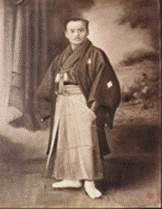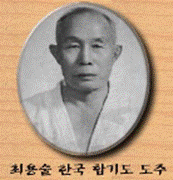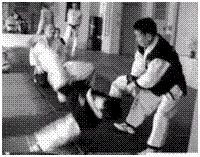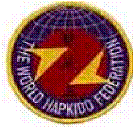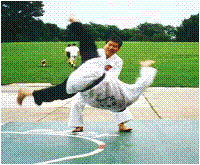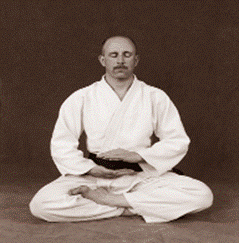




|
Indiana Taekwondo Academy |







|
Last updated: 12/2010 |

|
By Mark Castle – 2nd Dan Hapkido – A Dynamic Study of Integration Hapkido is a Martial Art that has roots leading primarily from two countries, Korea and Japan. Hapkido means, “The Way of Coordinated Power”. Hapkido is a path to harmonize with earth, heaven, and nature. It is a study in the methods to enhance internal and external power. The cultivation of this power can be used for the defense of oneself and others. It contains a blend of the two major styles of the martial arts, “hard and soft”. Hard-styles contain direct techniques of a linear (direct) nature. Soft-styles contain circular techniques that use the opponents own force against them, which enables a much smaller person to defend themselves against a larger opponent. Hapkido has a compliment of both styles contained in its techniques. The techniques of Hapkido are combative, not competitive and are unsuitable for use in competitions. The Japanese Connection In 1913, during the Japanese occupation of Korea, the young boy Young Sool Choi was an orphan. He was abducted from Korea and taken to Japan to be a personal slave to a Japanese candy maker. The candy maker could not support the food and expenses required for this endeavor and abandoned him soon after arrival to Japan. The connection to Japan begins with the founder of the Daito-Ryu (Great Eastern Style) Aikijitsu and is tied to the Minamoto Clan. Emporor Seiwa Tenno is credited with founding the Daito-Ryu in 850 A.D.. The Daito-Ryu has a rich history with many of the Samurai Warrior’s rising to leadership positions throughout Japan’s centuries of civil wars. The Daito-Ryu clan had a line of descendants over the centuries leading to Sakaku Tekeda. Sokaku Tekeda (1859-1943) was renowned as a Great Master in the Daito-Ryu heritage. He reportedly trained over 30,000 people although he was totally illiterate. He was in his prime at 43 years old when he received a new houseboy, Young Sool Choi. Young Sool Choi was given to Sakaku Tekeda as a personal assistant (houseboy) and for the next 30 years he was constantly at his side. Because of the excellent job he performed, he was allowed to begin practicing Aikijitsu. As a live-in student (Uchi-Denshi), he began by cleaning the Dojo and watching the students practice for the first 6 months. He was invited to begin training and eventually earned the title of “Assistant in all Instruction” from Sokaku Tekeda. Over the course of the next 30 years he developed into a Master of the Daito-Ryu Style. While in Japan, Young Sool Choi was given a Japanese name of Asao Yoshida. At the time of Sakaku Tekeda’s death (1943), Young Sool Choi was told to return to Korea and spread the techniques he had learned. During this time in history, it would have been very dangerous for a Korean to have stayed in Japan. Another student of Sakaku Tekeda was Morehei Uyshiba and is known as O’ Sensei. In 1943, after 20 years of studying Daito-Ryu techniques, he founded the Japanese Art of Aikido. The original (True) Aikido is a use of the techniques within the Daito-Ryu to demonstrate and better understand the laws of the Universe and the rules of life. To the uninformed, Aikido looks like a dance with willing partners, but to those who are familiar with the art realize the power and precision within the application of each technique. The Daito-Ryu still continues to this day in Japan. In 1994, Dari Katsuyuki Kondohe was appointed the leader of the Daito-Ryu to continue its long standing traditions and the protection of its techniques. The Korean Connection The Korean’s also had a long standing history in the Martial Arts. The Martial Art of Tae Kyon is the ancient kicking skill that was widespread during the time of the Three Kingdoms (Koguryo, Paekje, and Silla) (668A.D.) instilled into Korea’s history. The Korean Arts are “hard” style and focused on linear techniques. There is a strong foundation of punching and kicking seen in the cultivation of the Martial Arts created in Korea that have been prevalent for centuries. When Young Sool Choi returned to Korea from Japan, the transformation began. The Transformation In 1943, Young Sool Choi returned to his native country, Korea. Master Choi held several odd jobs while trying to begin a Martial Art school in Korea. He integrated many of Korea’s strikes and kicking movements into the repertories of techniques he learned from the Daito-Ryu. He began teaching classes in Korea during the integration process of development that lead to the creation of a new Martial Art, Hapkido. Young Sul Choi (1904-1986) is credited as the founder of Korean Hapkido (name used in 1958). Grandmaster Choi integrated kicks and weapons used in many Korean Martial Arts into the curriculum. The Martial Art of Hapkido quickly spread throughout Korea. Virtually every town in Korea has a Hapkido school contained within it. Hapkido has become part of the cultural arts that Korea is now famous for. Grandmaster Choi has trained thousands of students in Hapkido. There are four students who stand out from the rest and deserve recognition. Grandmaster Ji Han-Jae, Grandmaster Bong-Soo Han, Grandmaster Kwang-Sik Myung, and Grandmaster Tae-Man Kwon all began their training under the founder of Hapkido, Grandmaster Young Sool Choi. They were all his first generation students who worked their way up to achieve mastery of the techniques of Hapkido. Each one of the Grandmasters have developed their own organizations and deserve recognition for the contributions they have made to spreading Hapkido throughout the World. Hapkido in Korea is overseen by three organizations: The Korean Kido Federation, The Korean Hapkido Federation, and The International Hapki Federation. The Korean Kido Federation (President, In Sun Seo, 1983) was granted the right to regulate and supervise the standards of teaching as well as promotional requirements of Black Belts for 31 different Korean Martial Arts in 1963 by the Korean Government. One of the early students of Young Sool Choi was Kwang Sik Myung. He began studying martial arts at the age of eight and achieved his 1st Dan in Hapkido at the age of twelve years old. Master Myung has dedicated almost his whole life for the development and spread of Hapkido. While in Korea, he moved throughout his life carrying the tenants of Hapkido and sharing them with anyone willing to learn. Master Myung was appointed a permanent Director of the Korean Hapkido Association. Master Myung was extended an invitation to visit the United States from the Government in the late 1950’s. He moved to the United States around 1960. The American Connection The first Hapkido School opened in the United States in 1964. Sea Oh Choi, at the time a 5th Dan Black Belt, immigrated to America and opened the first school in Los Angeles, California. He found that his techniques were readily accepted from all his students. Hapkido was growing in popularity all along the West Coast. Grandmaster Kwan Sik Myung migrated to Detroit, Michigan. Grandmaster Myung opened a Hapkido School in Detroit Michigan in the early 1960’s. Hapkido continued its rise to fame and popularity throughout the world during this time in its growth phase. Grandmaster Myung founded the World Hapkido Federation in 1973. The World Hapkido Federation now has thousands of members in 30 different countries and is now one of the largest Martial Arts organizations in the world. One of Grandmaster Myung’s Students is Master Crays of the Indiana TaeKwonDo Academy. Master Crays has studied Hapkido while associated with his 30+ years of TaeKwonDo training and teaching under Grand Master Chul Koo Yoon. In 1999, Master Crays began the focused study of Hapkido from Grandmaster Myung. The Hapkido curriculum at the Indiana TaeKwonDo Academy has been in intense development for the last seven years. The class began with all Black Belts in TaeKwonDo and has grown to accept new students who wish to learn the traditional ways of Hapkido. The Blended Arts - Hapkido The major difference between Hapkido and Aikijitsu is found in Hapkido’s addition of kicks and powerful hand striking techniques to generate a balance between the soft and hard styles of Japanese and Korean Martial Arts. Hapkido has evolved into a unique blend of meditation, kicks, strikes, punches, joint locks, chokes, pressure points, pins, grappling, ground fighting and energy throws which no other form of martial art can boast. Hapkido has thousands of movements and techniques (3,864), so there is always a new element to study, refine, and master. Martial Arts should be a method to defend yourself only when it’s absolutely necessary – other than that, it should be seen as a method to focus your body, mind, and spirit. Martial Arts train your body to become acutely in tune with your mind. From this, you can raise your consciousness to a much more refined level of intuitive understanding than is possessed by the average individual. Traditional Martial Arts training teaches us to seek peaceful solutions to all conflicts even though it is based on warfare techniques. The ability to handle a situation without fighting is the primary aim of the true Martial Arts. The development of inner power is very important. The development of Ki energy is a primary aim for the student of Hapkido. Ki is the universal life force of all living things; it nourishes and sustains all life. Ki is linked to the breath. The breath is the dominate factor of life. The mastery of the breath or breath control is the primary technique in harnessing and developing Ki. Though Ki can not be physically touched, the essence of its energy has been documented for centuries. There are three primary principles visible during the observation of Hapkido techniques being executed. The first is Yu, the theory of flowing water. The theory states that you should never meet the force head on. Instead, you should divert the flow of the attack with softness and disperse it. The fluid movements maximize the Um and Yang (yin/yang) of change and opens up the opponent’s weaknesses towards the techniques found in Hapkido. The fluid movements are easily used to move between offensive and defensive needs during a confrontation. The secondly theory is Won, the theory of the circle. Circular movements make it possible to use the attacker’s force against them. The stronger the attacking force is, the more strength can be used in retaliation. The last principle is Wha, the theory of harmony. The ability to harmonize with the opponents force and make that force your own enables a smaller defender to gain leverage over a much larger attacker. Harmony also entails the integration of your own mind, body, and spirit. The overall goal is to harmonize ourselves into the natural life force contained within the Universe. Summary The study of Hapkido develops inner personal discipline. The discipline over time creates inner strength and self reliance. A subtle growth gradually occurs within each individual who studies Hapkido which is a life changing event. Our perception of ourselves, the world we live in, and our contribution to the universe becomes apparent over a life-time of study. The Do of Hapkido is a path, not a destination. The student has a lifetime to learn, develop, and refine the principles while traveling the path into their future. “To Win One Hundred Victories in One Hundred Battles is not the Highest Skill. To subdue the Enemy Without Fighting is the Highest Skill.” Sun-Tzu Pictorial Gallery
Sokaku Tekeda – Grandmaster Daito-Ryu Aikijitsu
Grandmaster Young Sool Choi – Founder of Hapkido
Grandmaster Kwang Sik Myung – Founder of the World Hapkido Federation
Grandmaster In Sun Seo – President of The Korean Kido Federation |
|
Hapkido "The Way of Focused Energy"
|
